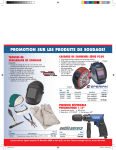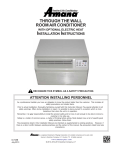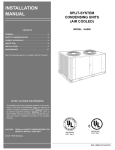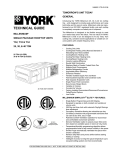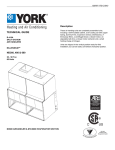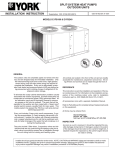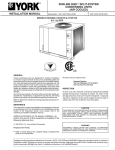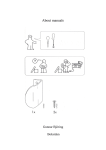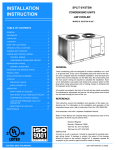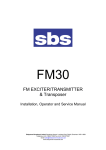Download York EA090 Installation manual
Transcript
INSTALLATION INSTRUCTION SPLIT-SYSTEM HEAT PUMPS OUTDOOR UNITS CONTENTS GENERAL 4 SAFETY CONSIDERATIONS . . . . . . . . . . . . . . . . . . . . .4 AGENCY APPROVALS . . . . . . . . . . . . . . . . . . . . . . . . . .4 INSPECTION . . . . . . . . . . . . . . . . . . . . . . . . . . . . . . . . . .4 INSTALLATION . . . . . . . . . . . . . . . . . . . . . . . . . . . . . . . .5 START-UP . . . . . . . . . . . . . . . . . . . . . . . . . . . . . . . . . . .17 OPERATION . . . . . . . . . . . . . . . . . . . . . . . . . . . . . . . . .18 MAINTENANCE . . . . . . . . . . . . . . . . . . . . . . . . . . . . . . .21 See the following page for a complete Table of Contents. MODEL: EA090 NOTES, CAUTIONS AND WARNINGS Installer should pay particular attention to the words: NOTE, CAUTION, and WARNING. Notes are intended to clarify or make the installation easier. Cautions are given to prevent equipment damage. Warnings are given to alert installer that personal injury and/or equipment damage may result if installation procedure is not handled properly. CAUTION: READ ALL SAFETY GUIDES BEFORE YOU BEGIN TO INSTALL YOUR UNIT. 208/230/460 VOLT ONLY SAVE THIS MANUAL 035-18474-001-A-0602 035-18474-001-A-0602 TABLE OF CONTENTS NOMENCLATURE . . . . . . . . . . . . . . . . . . . . . . . . . . . 3 GENERAL . . . . . . . . . . . . . . . . . . . . . . . . . . . . . . . . . . . . 18 GENERAL . . . . . . . . . . . . . . . . . . . . . . . . . . . . . . . . . 4 SYSTEM SEQUENCE OF OPERATION. . . . . . . . . . . . . 18 SAFETY CONSIDERATIONS . . . . . . . . . . . . . . . . . . 4 COOLING OPERATION . . . . . . . . . . . . . . . . . . . . . . . . . . . . . 18 REFERENCE . . . . . . . . . . . . . . . . . . . . . . . . . . . . . . . . . . . 3 HEATING OPERATION . . . . . . . . . . . . . . . . . . . . . . . . . . . . . 19 DEFROST CYCLE . . . . . . . . . . . . . . . . . . . . . . . . . . . . . . . . . 20 AGENCY APPROVALS. . . . . . . . . . . . . . . . . . . . . . . 4 OPERATION BELOW 0ºF OUTDOOR TEMPERATURE . . . . 20 INSPECTION . . . . . . . . . . . . . . . . . . . . . . . . . . . . . . . 4 EMERGENCY HEAT OPERATION . . . . . . . . . . . . . . . . . . . . 20 INSTALLATION . . . . . . . . . . . . . . . . . . . . . . . . . . . . . 5 SAFETY FEATURES. . . . . . . . . . . . . . . . . . . . . . . . . . . . 20 LIMITATIONS. . . . . . . . . . . . . . . . . . . . . . . . . . . . . . . . . . . 5 LOCATION. . . . . . . . . . . . . . . . . . . . . . . . . . . . . . . . . . . . . 5 SECURE OWNER’S APPROVAL . . . . . . . . . . . . . . . . . . 21 MAINTENANCE . . . . . . . . . . . . . . . . . . . . . . . . . . . . 21 ROOF-TOP LOCATIONS . . . . . . . . . . . . . . . . . . . . . . . . . . . . . . 5 CLEANING . . . . . . . . . . . . . . . . . . . . . . . . . . . . . . . . . . . 21 GROUND LEVEL LOCATIONS . . . . . . . . . . . . . . . . . . . . . . . . . 6 LUBRICATION. . . . . . . . . . . . . . . . . . . . . . . . . . . . . . . . . 21 RIGGING AND HANDLING . . . . . . . . . . . . . . . . . . . . . . . . 6 REPLACEMENT PARTS. . . . . . . . . . . . . . . . . . . . . . . . . 21 CLEARANCES. . . . . . . . . . . . . . . . . . . . . . . . . . . . . . . . . . 7 NOTICE TO OWNER . . . . . . . . . . . . . . . . . . . . . . . . . . . 21 COMPRESSORS. . . . . . . . . . . . . . . . . . . . . . . . . . . . . . . . 8 LIST OF FIGURES COMPRESSOR CRANKCASE HEATER . . . . . . . . . . . . . . . . . . 8 POWER AND CONTROL WIRING . . . . . . . . . . . . . . . . . . 8 Fig. # Pg. # POWER WIRING . . . . . . . . . . . . . . . . . . . . . . . . . . . . . . . . . . . . 8 1 CENTER OF GRAVITY . . . . . . . . . . . . . . . . . . . . . . . . 6 CONTROL WIRING . . . . . . . . . . . . . . . . . . . . . . . . . . . . . . . . . . 8 2 TYPICAL RIGGING . . . . . . . . . . . . . . . . . . . . . . . . . . . 7 WIRE SIZING . . . . . . . . . . . . . . . . . . . . . . . . . . . . . . . . . . . . . . . 8 3 UNIT DIMENSIONS AND CLEARANCES 7-1/2 TON . . . . . . . . . . . . . . . . . . . . . . . . . . . . . . . . . . 7 REFRIGERANT PIPING . . . . . . . . . . . . . . . . . . . . . . . . . 10 4 TYPICAL FIELD WIRING . . . . . . . . . . . . . . . . . . . . . . 9 GENERAL GUIDELINES . . . . . . . . . . . . . . . . . . . . . . . . . . . . . 10 5 FIELD PIPING DIAGRAMS . . . . . . . . . . . . . . . . . . . . 11 LINE SIZING . . . . . . . . . . . . . . . . . . . . . . . . . . . . . . . . . . . . . . . 10 6 EXTENDING THE SERVICE PORTS . . . . . . . . . . . . 14 SERVICE VALVES . . . . . . . . . . . . . . . . . . . . . . . . . . . . . . . . . . 11 7 REFRIGERANT FLOW DIAGRAM . . . . . . . . . . . . . . 16 EXTENDING THE SERVICE PORTS . . . . . . . . . . . . . . . 12 8 CHARGING CURVE EA090 (COOLING MODE . . . . . . . . . . . . . . . . . . . . . . . . . . . 17 INSTALLATION . . . . . . . . . . . . . . . . . . . . . . . . . . . . . . . . . . . . 12 LIST OF TABLES EVACUATING AND CHARGING. . . . . . . . . . . . . . . . . . . 14 ALTERNATE CHARGING METHODS . . . . . . . . . . . . . . . . . . . 15 Tbl. # Pg. # BALANCE POINT SETTING . . . . . . . . . . . . . . . . . . . . . . 15 1 PHYSICAL DATA. . . . . . . . . . . . . . . . . . . . . . . . . . . . . 5 START-UP . . . . . . . . . . . . . . . . . . . . . . . . . . . . . . . . 17 2 UNIT APPLICATION DATA . . . . . . . . . . . . . . . . . . . . . 5 3 ELECTRICAL DATA . . . . . . . . . . . . . . . . . . . . . . . . . . 9 4 LIQUID LINES . . . . . . . . . . . . . . . . . . . . . . . . . . . . . . 10 CRANKCASE HEATER . . . . . . . . . . . . . . . . . . . . . . . . . . 17 PRE-START CHECK . . . . . . . . . . . . . . . . . . . . . . . . . . . . 17 5 VAPOR LINES . . . . . . . . . . . . . . . . . . . . . . . . . . . . . . 11 INITIAL START-UP . . . . . . . . . . . . . . . . . . . . . . . . . . . . . 18 6 REFRIGERANT LINE CHARGE . . . . . . . . . . . . . . . . 12 OPERATION . . . . . . . . . . . . . . . . . . . . . . . . . . . . . . 18 2 Unitary Products Group 035-18474-001-A-0602 NOMENCLATURE PRODUCT NOMENCLATURE YORK OUTDOOR SPLIT CONDENSING UNITS AND HEAT PUMPS E A 120 C 00 A 2 A AA 1 A Model Number Description Options E Product Category H = Air Conditioner Split System E = Heat Pump Split System A Product Identifier A = R-22 Standard Efficiency 2-Pipe B = R-22 Standard Efficiency 4-Pipe 120 Nominal Cooling Capacity MBH 090 = 7-1/2 Ton 120 = 10 Ton 150 = 12-1/2 Ton 180 = 15 Ton 240 = 20 Ton C Heat Type C = Cooling Only 00 Nominal Heating Capacity 00 = No Heat Installed A Airflow Options A = Standard Motor 2 Voltage 2 = 208/230-3-60 4 = 460-3-60 A Installation Options A = None B = Disconnect AA Additional Options AA = None AC = Technicoated Coil 1 Product Generation 1 = 1st Generation 2 = 2nd Generation A Product Style A = Style A B = Style B Model # 300 = 25 Ton * 360 = 30 Ton * 480 = 40 Ton * 600 = 50 Ton * *NOT AVAILABLE IN HEAT PUMP Unitary Products Group 3 035-18474-001-A-0602 GENERAL These heat pump units are designed for outdoor installation on a roof or at ground level. Every unit is completely piped and wired at the factory and is shipped ready for immediate installation. Only the liquid and vapor lines to the indoor coil, the control wiring and the main power wiring are required to complete the installation. Each unit is dehydrated, evacuated, leak tested and pressure tested at 450 psig before being pressurized with a holding charge of Refrigerant-22 for shipment and/or storage. Every unit includes a heavy-duty compressor with line break overload protection, a suction line accumulator, a 4-way reversing valve, a filter-drier, an expansion valve, a distributor, a check valve, and a copper tube/ aluminum fin coil. All controls are readily accessible for maintenance, adjustment and service. All power and control wiring can be routed through the front of the unit. SAFETY CONSIDERATIONS Installer should pay particular attention to the words: NOTE, CAUTION and WARNING. Notes are intended to clarify or make the installation easier. Cautions are given to prevent equipment damage. Warnings are given to alert the installer that personal injury and/or equipment damage may result if the installation procedure is not handled properly. Improper installation may create a condition where the operation of the product could cause personal injury or property damage. REFERENCE This instruction covers the installation of the outdoor unit. For information on the installation of the matching indoor unit, refer to Part Number 035-18475-001. All accessories come with a separate installation manual. Refer to Parts Manual for complete listing of replacement parts on this equipment. The above form may be ordered from: Standard Register 2101 W. Tecumseh Rd. Norman, OK 73069 TOLL FREE Tel.: 877-318-9675 TOLL FREE Fax: 877-379-7920 AGENCY APPROVALS Design certified by UL as follows: 1. For use as a cooling/heat pump unit only. 2. For outdoor installation only. INSPECTION This product must be installed in strict compliance with the enclosed installation instructions and any applicable local, state, and national codes including, but not limited to, building, electrical, and mechanical codes. 4 As soon as a unit is received, it should be inspected for possible damage during transit. If damage is evident, the extent of the damage should be noted on the carrier's freight bill. A separate request for inspection by the carrier's agent should be made in writing. See Form 50.15-NM for more information. Unitary Products Group 035-18474-001-A-0602 TABLE 1: PHYSICAL DATA 1 Compressor MODEL EA090 Rating, (Tons) 7-1/2 Quantity Fans 2 Diameter, (In.)/No. Blades 24/3 Nominal CFM 7600 HP Fan Motors2 Coil 3/4 RPM 1100 Face Area, (Sq. Ft.) 24.00 Rows Deep x Rows High 2 x 36 Finned Length, (In.) 96 Tube (Copper) OD - inches 3/8 Fins (Aluminum) per inch 16 Holding Charge 2.25 Refrigerant-22 Operating Charge3 (Lbs.) Pumpdown Capacity4 18.8 Unit Weight (Lbs.) Shipping 510 Operating 505 1. 2. 3. 4. 24.6 These compressors are fully hermetic. These PSC motors are directly connected to the outdoor fans and have inherent protection, ball bearings and a 48” frame. Includes outdoor unit and matched indoor blower unit, but no piping. Refer to Table 6 for refrigerant line charge. Based on a 95ºF ambient. Voltage Variation (Min/Max.)1 187/252 432/504 Air Temperature on OUTDOOR Coil, ºF Minimum Maximum Cool Heat Cool Heat 40db 0db2 115db 75db Air Temperature on INDOOR Coil, ºF Minimum Cool 57wb Maximum Heat 50db 3 Cool Heat 72wb 80db Maximum Line Lengths - 125 ft. 1. 2. 3. LOCATION Use the following guidelines to select a suitable location for these units. 1. The outdoor units must be installed outside the building. The outdoor fans are the propeller type and are not suitable for use with duct work. 2. The outdoor and indoor units should be installed as close together as possible and with a minimum number of bends in the refrigerant piping. Refer to REFRIGERANT PIPING for additional information. 3. The outdoor unit should not be installed beneath windows or between structures where normal operating sounds may be objectionable. The outdoor unit should not be installed in an area where mud and/or ice could cause personal injury. Remember that condensate will drip from the underside of the unit coils during heat and defrost cycles and that this condensate will freeze when the temperature of the outdoor air is below 32°F. TABLE 2: UNIT APPLICATION DATA 208/230-3-60 460-3-60 codes. See Table 2 for unit application data. Units are designed to meet National Safety Code Standards. If components are to be added to a unit to meet local codes, they are to be installed at the dealer's and/or the customer's expense. Rated in accordance with ARI Standard 100, utilization range “A”. Below 0ºF, the control system stops the compressor and allows the electric heat accessory to cycle at its standby capacity. Operation below this temperature is permissible for a short period of time when a unit is required to heat the conditioned space up to 50ºF. INSTALLATION 4. All units require certain clearances for proper operation and service. Refer to General Installation Form 55.70-N1 for additional guidelines. On either roof top or ground level installations, rubber padding can be applied between the base rails and their supports to lessen any transmission of vibration. ROOF-TOP LOCATIONS Be careful not to damage the roof. Consult the building contractor or architect if the roof is bonded. Choose a location with adequate structural strength to support the unit. LIMITATIONS These units must be installed in accordance with all national and local safety codes. If no local codes apply, installation must conform with the appropriate national Unitary Products Group The unit must be mounted on solid level supports. The supports can be channel iron beams or wooden beams treated to reduce deterioration. 5 035-18474-001-A-0602 A minimum of two (2) beams are required to support each unit. The beams should: (1) Be positioned perpendicular to the roof joists. (2) Extend beyond the dimensions of the unit to distribute the load on the roof, (3) Be capable of adequately supporting the entire unit weight. Refer to Figure 1 and Table 1 for load distribution and weights. These beams can usually be set directly on the roof. Flashing is not required. NOTE: On bonded roofs, check for special installation FIGURE 1 - CENTER OF GRAVITY requirements. GROUND LEVEL LOCATIONS The units must be installed on a substantial base that will not settle. Any strain on the refrigerant lines may cause a refrigerant leak. A one-piece concrete slab with footers that extend below the frost line is recommended. The slab should not be tied to the building foundation because noise and vibration will telegraph into the building. A unit can also be supported by concrete piers. These piers should: (1) extend below the frost line, (2) be located under the unit's four corners and (3) be sized to carry the entire unit weight. Refer to Figure 1 and Table 1 for the center of gravity and unit weight. A gravel bed or some other means of handling the condensate that will drop from the underside of the unit coil during the heating and defrost cycles may have to be provided. Care should be taken to protect the unit from tampering and unauthorized persons from injury. Screws on access panels will prevent casual tampering. Additional safety precautions such as fences around the unit or locking devices on the panels may be advisable. Check local authorities for safety regulations. Unit 7-1/2 Ton Dim. (In.) A B C D 70-1/8 32 29-5/8 16-1/2 RIGGING AND HANDLING Exercise care when moving the unit. Do not remove any packaging until the unit is near the place of installation. Rig the unit by attaching nylon straps with hooks to the lifting holes provided in the base rails. Spreaders, whose length exceeds the largest dimension across the unit, MUST be used across the top of the unit if the rigging height above the top of the unit is less than 5 feet. See Figure 2. Do not use straps under the unit or through the fork lift slots for lifting purposes. Sharp metal edges can damage the straps and could result in personal injury or equipment damage. BEFORE LIFTING A UNIT, MAKE SURE THAT ITS WEIGHT IS DISTRIBUTED EQUALLY ON THE STRAPS SO THAT IT WILL LIFT EVENLY. Units may also be moved or lifted with a fork-lift. Slotted openings in the base rails are provided for this purpose. LENGTH OF FORKS MUST BE A MINIMUM OF 54" when lifting from either side. Remove the nesting brackets from the four corners on top of the unit. All screws that are removed to take these brackets off must be replaced on the unit. 6 Unitary Products Group 035-18474-001-A-0602 W A R N IN G B e fo r e liftin m a k e s u re is d is tr ib u te th e c a b le s lift e v e n ly . S P R E A D E R B A R g th e u th a t its d e q u a s o th a t n it, w e ig h t lly o n it w ill Do not permit overhanging structures or shrubs to obstruct air discharge. Additional height may be required for snow clearance if winter operation is expected. CLEARANCES L IF T IN G H O L E S FIGURE 2 - TYPICAL RIGGING Overhead (Top)1 120” Front (Piping and Access Panels) 30” Left Side 24” Right Side 24” Rear 24” Bottom2 0” 1. CLEARANCES 2. All units require certain minimum clearances for proper operation and service. Refer to Figure 3 for these clearances. Units must be installed outdoors. Overhanging structures or shrubs should not obstruct air discharge outlet. Adequate snow clearance must be provided if winter operation is expected. All dimensions are in inches. They are subject to change without notice. Certified dimensions will be provided upon request. EA090 AIR OUT AIR OUT CONTROL BOX ACCESS SERVICE PORT LOCATION 39 AIR IN 1-1/8 OD SUCTION LINE 5/8 OD LIQUID LINE 15-3/4 7-3/4 2-3/4 8-3/4 5-3/8 32 2-1/4 5-7/8 32-1/2 7/8" KNOCKOUT ACCESSORY WIRING ENTRY 6-3/4 7/8 DIA CONTROL WIRING ENTRY 70-1/2 1-3/8 DIA. POWER WIRING ENTRY COMPRESSOR AND CONDENSER FAN MOTOR ACCESS CONDENSER FAN MOTOR ACCESS FIGURE 3 - UNIT DIMENSIONS AND CLEARANCES - 7-1/2 TON Unitary Products Group 7 035-18474-001-A-0602 COMPRESSORS Units are shipped with compressor mountings factoryadjusted and ready for operation. The field-supplied disconnect switch must be suitable for an outdoor location. Although it should be installed near the unit, do NOT secure it to the unit cabinet. Refer to Figure 4 for typical field wiring. CONTROL WIRING Do Not loosen compressor mounting bolts. COMPRESSOR CRANKCASE HEATER The compressor is equipped with a crankcase heater to prevent refrigerant from mixing with crankcase oil during the “OFF” cycle. The heaters will be energized when the compressor is not running providing the unit disconnect switch is closed. Do not attempt to start the compressor without at least eight hours of crankcase heat or compressor damage will occur. If a unit has just been installed or the unit disconnect switch has been open for a long period of time, move the system switch on the room thermostat to the “OFF” position before closing the unit disconnect switch. Eight hours of crankcase heat are required to drive the liquid refrigerant out of the compressor before the compressor can be started. POWER AND CONTROL WIRING Install electrical wiring in accordance with the latest National Electrical Code (NFPA Standard No. 70) and/ or local regulations. The unit should be grounded in accordance with these codes. POWER WIRING Check the voltage of the power supply against the data on the unit nameplate. Check the size of the power wire, the disconnect switch and the fuses against the data on Table 3. NOTE: Copper conductors must be installed between the disconnect switch and the unit. Refer to Figure 3 for the location of the power wire access opening through the front of the unit. This opening will require a field-supplied conduit fitting. 8 Refer to Figure 3 for the location of the control wire access opening through the front of the unit. Route the necessary low voltage control wires from terminal block 1TB of the unit control box through this access opening to the indoor unit and to the room thermostat. Refer to Figure 4 for typical field wiring. The room thermostat should be mounted about 5 feet above the floor and located where it will be exposed to normal room air circulation. Do not locate it on an outside wall, near a supply air grill, or where it may be affected by sunlight and/or drafts. Circulation of air to the thermostat should not be blocked by curtains, drapes, furniture, partitions, etc. Some installations may require a locking cover to protect the thermostat from tampering and/or damage. RECOMMENDED WIRE SIZE MAXIMUM TOTAL CIRCUIT LENGTH - FT.* #19 Solid #18 Solid 130 170 #18 Stranded #16 Stranded 180 270 #14 Stranded #12 Stranded 455 730 *To determine the total circuit length, add the following distances: 1 - Outdoor Unit to Indoor Unit ...................... 2 - Indoor Unit to Thermostat......................... 3 - Thermostat to Indoor Unit......................... 4 - Indoor Unit to Outdoor Unit ...................... Total Circuit Length.... _________ _________ _________ _________ _________ Both the manual and the auto changeover thermostats have non-adjustable, voltage-type anticipators for both cooling and heating. WIRE SIZING Refer to the following chart to size the control wiring properly. If the wiring is undersized, voltage drop could become excessive and result in malfunctioning of the unit controls. Unitary Products Group 035-18474-001-A-0602 TYPICAL NOTE: SEE PN# 036-13335-002 FOR APPLICABLE THERMOSTATS. FIGURE 4 - TYPICAL FIELD WIRING TABLE 3: ELECTRICAL DATA Model EA 090A 1. Compressor Power Supply RLA LRA 25 200/230-3-60 25.6 190.0 46 460-3-60 12.8 95.0 Outdoor Fan Motor Power Factor 0.94 @ 208V 0.84 @ 230V 0.86 Qty. Min. Circuit Amps Max. Fuse Size Min. Wire FLA (Each 208/230-1-60 2 3.03 38.1 60 8 460-1-60 2 1.6 19.2 30 10 Power Supply Size,1 AWG Based on three, 50ºC insulated copper conductors in steel conduit. Unitary Products Group 9 035-18474-001-A-0602 REFRIGERANT PIPING TABLE 4: LIQUID LINES GENERAL GUIDELINES Many service problems can be avoided by taking adequate precautions to provide an internally clean and dry system and by using procedures and materials that conform with established standards. Use hard drawn copper tubing where no appreciable amount of bending around pipes or other obstructions is necessary. Use long radius ells wherever possible with one exception - small radius ells for the traps in all vapor risers. If soft copper is used, care should be taken to avoid sharp bends which may cause a restriction. Pack fiber glass insulation and a sealing material such as permagum around refrigerant lines where they penetrate a wall to reduce vibration and to retain some flexibility. Support all refrigerant lines at minimum intervals with suitable hangers, brackets or clamps. Braze all copper to copper joints with Silfos-5 or equivalent brazing material. Do not use soft solder. Insulate all vapor lines with a minimum of 1/2" ARMAFLEX or equal. Liquid lines exposed to direct sunlight and/or high temperatures must also be insulated. Never solder vapor and liquid lines together. They can be taped together for convenience and support purposes, but they must be completely insulated from each other. Never exceed the maximum line length listed in Table 2. LINE SIZING The following factors should be considered when locating the indoor and outdoor units and when sizing the refrigerant lines for a split heat pump system. Refer to Figure 5. 10 System Model EA090/FA090 1. 2. 3. Pressure Drop2 Refrigerant Type “L” Copper Flow Rate,1 Vertical Rise Friction,3 Tubing, (Lbs/Min) (PSI/Ft.) (In. OD) (PSI/100 Ft.) 22.5 5/8 3.5 0.5 Based on Refrigerant-22 at the nominal cooling capacity of the system, a liquid temperature of 105ºF and a vapor temperature of 40ºF. Since refrigerant flow rates will be a little lower at the nominal heating capacity of each system, liquid line friction loss should always be based on cooling operation. These friction losses do not include any allowance for fittings. The total pressure drop of the liquid line for both friction and vertical rise must not exceed 50 PSI. If the pressure drop exceeds 40 PSI, the liquid refrigerant could flash before it reaches the expansion valve. This flashing will not only cause erratic valve operation and poor system performance, but could also damage the expansion valve. THE LIQUID LINE - The vertical rise should never exceed 50 feet because liquid refrigerant will lose 0.5 psi of static head for each vertical foot. The total pressure loss for a field-installed liquid line should never exceed 40 psi because the liquid refrigerant could flash before it reaches the expansion valve. This flashing will not only cause erratic valve operation and poor system performance, but could also damage the expansion valve. Total pressure loss includes the static head loss explained above plus the friction losses due to the length of the line (Table 4) and number of fittings in the line. When the indoor unit is above the outdoor unit, the friction loss through the 1-1/8" OD vapor riser will be more of a limiting factor than the loss of static head in the liquid riser. See Example #3 and #4 for the VAPOR LINE. THE VAPOR LINE - A vapor line should not only be sized for a friction loss of 3 psi (2°F) but also for the proper return of oil to the compressor during both the cooling and heating cycles. Friction loss should always be based on cooling operation because refrigerant flow rates will be greater during the cooling cycle than during the heating cycle. Unitary Products Group 035-18474-001-A-0602 #2 - 7-1/2 Ton System 51 feet of 1-1/8" OD, type “L” copper tubing (vertical) (51 feet x 4.7 psi/100 feet). . . . . . . . . . . . . . . . . 2.4 psi 6 feet of 1-3/8" OD, type “L” copper tubing (horizontal) (6 feet x 1.6 psi/100 feet). . . . . . . . . . . . . . . . . . 0.1 psi Fitting* . . . . . . . . . . . . . . . . . . . . . . . . . . . . . . . . . . . . 0.5 psi Vapor Line Pressure Drop = 3.0 psi *Determine the pressure drop of the fittings for each installation - DO NOT use the estimated values as shown in the above examples. Although longer vapor lines are permissible, friction losses exceeding 3 psi (2°F) will reduce system capacity in both the cooling and heating cycles. TABLE 5: VAPOR LINES System Model EA090/FA090 1. 2. FIGURE 5 - FIELD PIPING DIAGRAMS (Cooling/Heating Refrigerant Flow) 3. Refrigerant Flow Rate,1 (Lbs/Min) 22.5 Type “L” Copper Tubing (In. OD) Friction Loss, 2,3 (PSI/100 Ft.) 1-1/8 4.7 1-3/8 1.6 Based on Refrigerant-22 at the nominal cooling capacity of the system, a vapor temperature of 40ºF and a liquid temperature of 105ºF. Since refrigerant flow rates will be a little lower at the nominal heating capacity of each system, vapor line friction loss should always be based on cooling operation. Although vapor lines should be sized for a friction loss equivalent to a 2ºF change in saturation temperature (or approximately 3 psi), sizing the lines for the proper return of oil is more important. These friction losses do not include any allowance for fittings. Only use a 1-1/8” riser when the indoor unit is above the outdoor unit. Oil return will be critical during: SERVICE VALVES 1. The cooling cycle when the outdoor unit is above the indoor unit (detail 1 of Figure 5). These outdoor units have both vapor and liquid line service valves. 2. The heating cycle when the indoor unit is above the outdoor unit (detail 4 of Figure 5). Both valves are shipped from the factory front-seated and closed with the valve stem in the maximum clockwise position. When the indoor unit is above the outdoor unit, the size of the vapor riser must be reduced to 1-1/8" OD so that the velocity of the refrigerant will be great enough to carry oil up the riser during the heating cycle. When 1-1/8" OD tubing must be used for the riser, the maximum length for the vapor line will be greatly reduced as shown in the following examples. EXAMPLES: #1 - 7-1/2 Ton System 125 feet of 1-3/8" OD, type “L” copper tubing (125 feet x 1.6 psi/100 feet) . . . . . . . . . . . . . . . .2.0 psi Fitting* . . . . . . . . . . . . . . . . . . . . . . . . . . . . . . . . . . . .0.4 psi Vapor Line Pressure Drop = 2.4 psi Unitary Products Group These service valves are the back-seating type and have a 1/4" male flare access port for evacuating and charging the system. Shrader access valves are provided on the compressor vapor and discharge lines for pressure checking the system. All access ports are sealed with a removable cap. Never remove a cap unless the valve is fully backseated with its valve stem in the maximum counterclockwise position because the refrigerant charge will be lost. 11 035-18474-001-A-0602 EXTENDING THE SERVICE PORTS Refer to Figure 6: 1. Loosen the screws securing the service ports in shipping position. (See Figure 6). 2. Push the service ports through the corner post. 3. Tighten the screws to secure the service ports for installation. TABLE 6: REFRIGERANT LINE CHARGE1 Refrigerant Line2 Line Size, OD (In.) Refrigerant Charge (Lb/Ft) Liquid 5/8 0.113 Vapor 1. 2. 1-1/8 1-3/8 0.013 Charges are based on 40ºF suction temperature and 105ºF liquid temperature. Type “L” copper tubing. The dry nitrogen must always be supplied through a pressure regulating valve. Before installing the liquid line between the outdoor and indoor units, remove the copper disc from the liquid connection on the outdoor unit per the following procedure: 1. Make sure the refrigerant in the line has been recovered and that the liquid service valve on the unit is front-seated and closed. The valve stem should be turned to its maximum clockwise position. 2. Drill a small hole through the disc before unbrazing it to permit a flow of dry nitrogen through the connection while it is being unbrazed. INSTALLATION Since the condensing units are shipped with a holding charge of refrigerant-22, they can be checked for a refrigerant leak by depressing the stem on either of the service ports that extend through the cabinet. As soon as some internal pressure is relieved release the stem. DO NOT release the entire holding charge. If the unit has already lost its holding charge, it should be leak tested and the necessary repairs should be made. If the unit has maintained its holding charge, you can assume that it has no leaks and proceed with the installation. This hole is also required to prevent the internal pressure from building up as the disc is being unbrazed and from blowing the disc off. This warning applies to any disc being removed from a service valve, coil connection, etc. 3. Remove the cap from the 1/4" access port on the liquid line stop valve. 4. Connect a supply of dry nitrogen to this access port. When making a braze connection, wrap a wet rag around all tubing inside the unit to prevent damage to the other components. 5. Unbraze the copper disc from the liquid connection while maintaining a minimum flow of dry nitrogen through the connection. Dry nitrogen should always be supplied through a connection while it is being brazed or unbrazed because the temperature required to make or break a brazed joint is sufficiently high to cause oxidation of the copper unless an inert atmosphere is provided. The flow of nitrogen should be continued until the joint has cooled. After the disc has been removed, 1. Burnish the external surfaces of the liquid connection on the outdoor unit and the end of the fieldsupplied piping being used for the liquid line. NOTE: Clean surfaces are essential for a well brazed connection. 12 Unitary Products Group 035-18474-001-A-0602 2. Carefully clean the internal surfaces of the above. Any particles left on these surfaces may lead to a future system malfunction. 6. Braze the liquid line to the liquid connection on the indoor unit while maintaining a minimum flow of dry nitrogen through the liquid line, the indoor coil and the hole in the vapor disc. NOTE: Use only copper tubing that has been espe- cially cleaned and dehydrated for refrigerant use. If the tubing has been open for an extended period of time, it should be cleaned before being used. The liquid line connections can now be brazed while maintaining a minimum flow of dry nitrogen through the piping. NOTE: A filter-drier is factory-mounted in the outdoor unit for the heating cycle and in the indoor unit for the cooling cycle. Do NOT install another filter-drier in the fieldsupplied liquid line because refrigerant will flow in both directions on a heat pump system. 1. The matched air handlers are shipped with a small R-22 charge and they should be checked for leaks before installation. Drill a small hole through the sealing cap or disc in both the liquid and suction connection. If there is a pressure release, the evaporator has no leaks and you can proceed with installation. If the charge has been lost, the coils should be leak tested and the necessary repairs made. 2. Move the dry nitrogen supply from the access port on the liquid line service valve of the outdoor unit to the hole through the vapor disc on the indoor unit. 3. Unbraze the coil's liquid line disc while maintaining a flow of dry nitrogen across the connection and through the hole in the liquid line disc. 4. After the disc has been removed, burnish the external surfaces and clean the internal surfaces as outlined above. 5. Move the dry nitrogen supply back to the access port on the liquid line service valve. 7. Unbraze the disc on the vapor connection of the indoor unit while maintaining the flow of dry nitrogen. 8. After the disc has been removed, burnish the external surfaces and clean the internal surfaces as outlined above. The vapor piping can now be brazed to the vapor connection on the indoor unit while maintaining a minimum flow of dry nitrogen. Before brazing the vapor line to the outdoor unit, make sure the refrigerant in the line has been recovered, then remove the copper disc from its vapor connection per the following procedure: 1. Make sure that the vapor line service valve on the outdoor unit is front-seated and closed with its valve stem in the maximum clockwise position. 2. Drill a small hole through the disc before unbrazing it to permit a flow of dry nitrogen through the connection while its being unbrazed. 3. Move the dry nitrogen supply to the access port on the vapor line service valve of the outdoor unit. 4. Unbraze the disc on the vapor line connection of the outdoor unit while maintaining a minimum flow of dry nitrogen through the access port of the vapor line service valve and the hole in the vapor disc. 5. After the disc has been removed, burnish the external surfaces and clean the internal surfaces of the vapor connection and the vapor piping. The vapor line can now be brazed to the vapor connection on the outdoor unit while maintaining the flow of dry nitrogen. After the liquid and vapor lines have been installed, the system should be evacuated and charged. Unitary Products Group 13 035-18474-001-A-0602 SERVICE PORTS IN SHIPPING POSITION COPPER UNIT WALL 2 SCREWS COPPER TUBE CORNER POST UNIT WALL SIDE VIEW SERVICE PORTS IN INSTALLED POSITION LOOSEN SCREWS COPPER 2 SCREWS CORNER SIDE VIEW (AS SHIPPED) POST PUSH SERVICE PORTS THROUGH UNIT WALL TOP VIEW CORNER POST TIGHTEN SCREWS ( SERVICE PORTS EXTENDED ) SIDE VIEW ( SERVICE PORTS EXTENDED ) FIGURE 6 - EXTENDING THE SERVICE PORTS EVACUATING AND CHARGING With the liquid and suction line service valves closed, connect a vacuum pump through a charging manifold to the access ports on both the liquid and suction line service valves. NOTE: The vacuum pump connection should be short and no smaller than 3/8" O.D. The refrigerant lines and the evaporator coil can now be evacuated to 500 Microns without disturbing the charge in the condenser coil or the compressor. After proper evacuation and dehydration, charge refrigerant through the access port on the liquid line service valve allowing the vacuum to draw in as much refrigerant as possible. Do not charge liquid refrigerant through the compressor suction connection. 14 Do not attempt to start the compressor without at least 8 hours of crankcase heat or compressor damage will occur. To continue charging refrigerant, open the liquid and the suction line service valves fully. Turn the stem of the liquid service valve clockwise 1/4 turn to open its access port for reading pressure. Start the compressor (after 8 hours of crankcase heat), turn the stem of the suction line service valve clockwise 1/4 turn to open its service port and continue to charge refrigerant gas through this suction access port until you meet the conditions shown on the charging curve, Figure 8. Open the liquid and vapor line service valves fully to close their access ports after the system has been charged. Unitary Products Group 035-18474-001-A-0602 ALTERNATE CHARGING METHODS If you are starting a unit when the ambient temperature is higher or lower than those shown in Figure 8, either of the following methods may be used. Method 1: Determine the total weight of the refrigerant for the total system by adding the required charge for the outdoor unit, the indoor unit and the refrigerant lines using information in Tables 1 (Physical Data) and 6 (Refrigerant Line Charge). Using the charging procedures outlined above, weigh the required amount of refrigerant charge into the unit. Method 2: Install a field supplied moisture indicating sight glass in the liquid line between the filter-drier and the evaporator coil. Using the charging procedure outlined above, charge refrigerant until the moisture indicating sight glass is clear. Add approximately 1 extra pound of refrigerant to assure a liquid refrigerant seal at the expansion valve under all operating conditions. Block the flow of the condenser air, if necessary, to assure a head pressure of 280 psig during the charging procedure. Unitary Products Group NOTE: The installer should return to the job to verify the operating charge when the ambient temperature is within the conditions shown in Figure 8. BALANCE POINT SETTING The balance point of a heat pump is the lowest temperature at which the refrigeration system can heat the building without any supplemental resistance heat. The balance point is dependent upon 1. The outdoor design temperature, 2. The building heat loss at the outdoor design temperature, and 3. The heating capacity of the system at the outdoor design temperature. Refer to Form 515.41-AD1 to determine balance point. Refer to Form 690.63-N1V for details regarding the outdoor ambient balance point control accessory Model No. 2BP11700224. 15 035-18474-001-A-0602 FIGURE 7 - REFRIGERANT FLOW DIAGRAM 16 Unitary Products Group 035-18474-001-A-0602 EA090 Charge Curve 330 310 115º Ambient Discharge Pressure 290 105º Ambient 270 250 95º Ambient 230 210 85º Ambient 190 75º Ambient 170 55 60 65 70 75 80 85 90 95 Suction Pressure FIGURE 8 - CHARGING CURVE EA090 (COOLING MODE) START-UP 1. Have sufficient clearances been provided? CRANKCASE HEATER 2. Has all foreign matter been removed from the interior of the unit (tools, construction or shipping materials, etc.)? The crankcase heaters must be energized at least 8 hours before starting the compressor. To energize the crankcase heaters, the main disconnect switch must be closed. During this 8 hour period, the system switch on the room thermostat must be “OFF” to prevent the compressor from starting. 3. Have the outdoor fans been rotated manually to check for free rotation? 4. Are all wiring connections tight? 5. Does the available power supply agree with the nameplate data on the unit? DO NOT ATTEMPT TO START THE COMPRESSOR WITHOUT AT LEAST 8 HOURS OF CRANKCASE HEAT OR COMPRESSOR DAMAGE WILL OCCUR. Make sure that the bottom of the compressor is warm to the touch to prove crankcase heater operation. PRE-START CHECK Before starting the unit, complete the following check list: Unitary Products Group 6. Have the fuses, disconnect switch and power wire been sized properly? 7. Are all compressor hold-down nuts properly secured? 8. Are any refrigerant lines touching each other or any sheet metal surface? Rubbing due to vibration could cause a refrigerant leak. 9. Are there any visible signs of a refrigerant leak, such as oil residue? 17 035-18474-001-A-0602 10. Is any electrical wire laying against a hot refrigerant line? Keep in mind that this unit has a reverse cycle and that different lines will be hot during the “HEAT” and “COOL” cycles. Only two lines will remain cool for all cycles - the line between the compressor and the accumulator and the line between the accumulator and the reversing valve. During the heating cycle, when the reversing valve solenoid becomes de-energized, compressor discharge gas will be diverted to the indoor coil and the outdoor coil will become the evaporator. Refer to Figure 7 for illustration showing the flow of refrigerant through a heat pump system. INITIAL START-UP 1. Supply power to the unit through the disconnect switch prior to starting the compressor. 2. Move the system switch on the room thermostat to the “COOL” position, and lower its set point to energize both the compressor and the reversing valve. Cool air will be supplied to the conditioned space. 3. Check the compressor amperage. It should not exceed the RLA rating printed on the unit data plate or in Table 3 unless the ambient temperature is above 105°F. 4. Move the system switch on the room thermostat to the “HEAT” position, and increase the set point of the room thermostat until heating is required. The compressor will run, but the reversing valve will be de-energized. Warm air will be supplied to the conditioned space. 5. Check the operation of the indoor unit per Form 515.41-N2. 6. Check the entire system for refrigerant leaks. 7. Check for any abnormal noises and/or vibrations, and make the necessary adjustments to correct (e.g. fan blade touching shroud, refrigerant lines hitting on sheet metal, etc.) 8. After the unit has been operating for several minutes, shut off the main power supply at the disconnect switch and inspect all factory wiring connections and bolted surfaces for tightness. OPERATION Reversing valves and check valves are precise mechanical devices and will not tolerate any mechanical abuse such as hammering. If a refrigerant system isn't properly cleaned after a compressor burn-out, scale may build up at these devices and prevent them from operating properly. SYSTEM SEQUENCE OF OPERATION The following sequences of operation are based on using the manual changeover thermostat. Refer to the respective unit wiring diagram. COOLING OPERATION 1. The following controls will be energized through terminal O on the thermostat to put the system in the cooling mode. • Relay RW and reversing valve solenoid. 2. If the fan switch on the thermostat is in the “ON” position, indoor section blower motor contactor 10M will be energized through terminal G to provide continuous blower operation. If the switch is in the “AUTO” position, the blower will operate only when the thermostat calls for cooling operation. 3. When TC1 of the thermostat closes on a demand for cooling, a circuit is made from terminal Y through the defrost control board and safety switches to energize contactor 1M and relay RY1, starting the compressor. Contactor 2M is energized through the NO contacts of RY1-1 and the NC contacts of K2 on the defrost control board in order to start the outdoor fan motor(s). GENERAL NOTE: If discharge pressure falls below 180 PSI, PS During the cooling cycle, when the reversing valve solenoid becomes energized, operation will be the same as any conventional air conditioning system. 18 will open and de-energize No. 2 fan motor. Unitary Products Group 035-18474-001-A-0602 4. Relay RY1 also prevents the 10KW portion of accessory electric heat referenced as standby electric heat from being utilized whenever the compressor is in operation. This part of the circuit is covered under HEATING OPERATION. 5. The thermostat will cycle the unit to satisfy the cooling requirements of the conditioned space. 6. After the unit has shutdown from a cooling cycle or a power interruption, the anti-short cycle feature of the defrost control board will not permit the unit to restart for 5 minutes. This feature prevents the unit from short cycling. 7. If the discharge pressure reaches 430 psig, the HP control will open and the defrost control board will lock out the compressor. If the discharge temperature reaches 255°F, 2TH thermostat will open and the defrost control board will lock out the compressor. If the suction pressure falls to 7 psig, the low pressure switch will open and the defrost control will lock out the compressor. 8. If the control that caused the lockout has automatically reset, the unit can be restarted by one of the following: a. Turning the system switch on the thermostat to the “OFF” position and back to the “COOLING” position. b. Increasing the set point on the thermostat above the temperature in the conditioned space and then returning it to its original setting. Opening and closing the power supply main disconnect switch. IN ALL THREE RESET METHODS DESCRIBED ABOVE, A FIVE MINUTE TIME DELAY WILL TAKE PLACE AFTER THE RESET BEFORE THE UNIT WILL RESTART. HEATING OPERATION 1. Reversing valve is de-energized and the system will be in the heating mode. 2. If the fan switch on the thermostat is in the “ON” position, indoor section blower motor contactor 10M will be energized through terminal G to provide continuous blower operation. If the switch is in “AUTO” position, the blower will operate only when thermostat calls for heating operation. Unitary Products Group 3. When TH1 of the thermostat closes for first-stage heat, a circuit is made from terminal Y through the defrost control board and safety switches to energize contactor 1M and start the compressor. Contactor 2M is energized through the NO contacts RY1-1 which will start the outdoor fan motor(s). NOTE: If PS opens due to discharge pressure falling below 180 PSI, the No. 2 fan motor will continue to operate through the NC contacts of relay RW. 4. The thermostat will cycle the unit to satisfy the heating requirements of the conditioned space. 5. After the unit has shutdown from a heating cycle or a power interruption, the anti-short cycle feature of the defrost control board will not permit the unit to restart for 5 minutes. This feature prevents the unit from short cycling. 6. If the discharge pressure reaches 430 psig, the HP control will open and the defrost control board will lock out the compressor. If the discharge temperature reaches 255°F, 2TH thermostat will open and the defrost control board will lock out the compressor. If the suction pressure falls to 7 psig, the low pressure switch will open and the defrost control will lock out the compressor. 7. If the control that caused the lockout has automatically reset, the unit can be restarted by one of the following: a. Turning the system switch on the thermostat to the “OFF” position and back to the “HEATING” position. b. Decreasing the set point on the thermostat below the temperature in the conditioned space and then returning it to its original setting. c. Opening and closing the power supply main disconnect switch. IN ALL THREE RESET METHODS DESCRIBED ABOVE, A FIVE MINUTE TIME DELAY WILL TAKE PLACE AFTER THE RESET BEFORE THE UNIT WILL RESTART. 8. Supplemental electric heat (if installed) will be controlled by second stage TH2 of the thermostat. The supplemental electric heat circuit is controlled through low voltage terminals W, 60 and 66. The standby portion of electric heat (controlled through 19 035-18474-001-A-0602 low voltage terminal 53) cannot operate because relay RY1 is energized, opening the circuit to terminal 53, whenever the compressor is operating. 9. When second stage heating TH2 is satisfied, the supplemental heaters will be de-energized. DEFROST CYCLE When condensate freezes on the outdoor coil during heating operation, it must be defrosted before it blocks the flow of air across the coil. 1. A defrost cycle will be initiated by the defrost control board's timed defrost feature. 2. When the defrost cycle is initiated, the unit operates as follows: a. The reversing valve solenoid is energized through the defrost control board causing the unit to switch to the cooling cycle. b. Defrost control board de-energizes 2M contactor, causing the outdoor section fan(s) to shut down. c. Supplemental electric heat (if installed) will be energized through defrost control board. Only that portion of electric heat controlled through low voltage control terminal 66 will be energized by the defrost cycle. The operation of supplemental electric heat during unit defrost will prevent cold drafts in the conditioned space. will open, de-energizing contactor 1M which shuts down the compressor. Contacts 1 and 2 of thermostat 1TH are closed when contacts 1 and 3 are open. This feature allows the standby electric heat (if installed) to operate under control of first stage heating TH1 of the room thermostat whenever the compressor is shut-down by the 1TH control. The supplemental electric heat will continue to be controlled by the second stage TH2 of the room thermostat same as described under Item 8 of HEATING OPERATION. 2. The indoor section blower operation will be controlled by the first stage heating TH1 of the room thermostat if the fan switch is in the “AUTO” position. EMERGENCY HEAT OPERATION When the system switch on the room thermostat is placed in the EMERGENCY HEAT position, operation is as follows: 1. The emergency heat light on the room thermostat will be energized. 2. Compressor will not operate because the Y circuit of the room thermostat cannot be energized. 3. Supplemental and standby electric heat (if installed) will be controlled by first stage heating TH1 of room thermostat. 3. The defrost cycle will be terminated when: a. the liquid temperature exceeds 55°F, or b. 10 minutes have passed since defrost initiation. The 10 minute cycle time (independent of liquid line temperature) is controlled by the defrost control board. 4. At defrost termination, the unit returns to the normal heating operation. OPERATION BELOW 0°F OUTDOOR TEMPERATURE 1. At 0°F outdoor temperature, the low temperature compressor cutoff thermostat 1TH contacts 1 and 3 20 4. Indoor section blower will also be controlled by first stage heating TH1 if fan switch is in the “AUTO” position. SAFETY FEATURES 1. All outdoor fan motors have inherent protection with automatic reset. 2. Every compressor is internally protected against excessive current and temperature by a line break motor protector that is mounted inside the compressor housing and is connected between each winding and the common terminal. Unitary Products Group 035-18474-001-A-0602 This motor protector will interrupt power to the compressor if any of the following overload conditions occur: a. primary single phasing b. locked rotor c. compressor overload d. insufficient motor cooling This type of motor protection works even with the contactor welded closed. 3. Every compressor is protected by crankcase heaters to prevent refrigerant from accumulating in the crankcases of the compressor during an “OFF” cycle. nect switches and the thermostat. Teach him how to start and stop the unit, how to adjust temperature settings within the limitations of the system, how the defrost cycle is controlled and how the anti-cycle timer operates. MAINTENANCE CLEANING Do not allow dirt to accumulate on the outdoor coil. Clean the coil with a brush or vacuum cleaner as often as necessary to assure good system performance and efficient operation. If the coil is extremely dirty, it may be necessary to use an industrial grade detergent and a hose to clean the fin surface. LUBRICATION 4. Outdoor fan motors and the secondary of the control transformer are grounded. 5. A fusible plug on the top of the suction line accumulator serves as a high temperature/high pressure relief device. The outdoor fan motors are equipped with factory lubricated and sealed ball bearings. They do not require any maintenance. REPLACEMENT PARTS Contact your local UPG Distribution Center for replacement compressors, fan motors, controls, etc. DO NOT ATTEMPT TO START THE COMPRESSOR WITHOUT AT LEAST 8 HOURS OF CRANKCASE HEAT OR COMPRESSOR DAMAGE WILL OCCUR. SECURE OWNER’S APPROVAL When the system is functioning properly, secure the owner’s approval. Show him the location of all discon- Unitary Products Group NOTICE TO OWNER If a lockout occurs, check the indoor filters and the outdoor coil before calling a serviceman. If the filters are dirty, clean or replace them. If there is an accumulation of snow, leaves or debris blocking the outdoor air coil, remove the blockage. Reset the thermostat and wait 5 minutes. If the unit doesn’t start, call a serviceman. 21 035-18474-001-A-0602 22 Unitary Products Group 035-18474-001-A-0602 Unitary Products Group 23 Subject to change without notice. Printed in U.S.A. Copyright © by Unitary Products Group 2002. All rights reserved. Unitary Products Group 035-18474-001-A-0602 Supersedes: 035-18474-000-B-0402 5005 York Drive Norman OK 73069

























